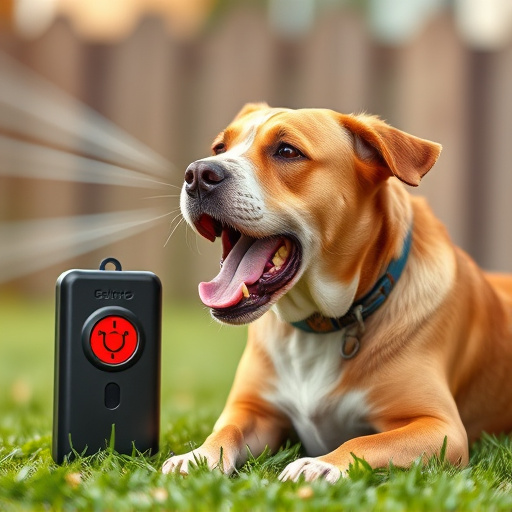Ultrasonic bark control systems, using high-frequency sound waves to discourage barking, are a humane and effective solution. For optimal results, place these devices near problem areas like balconies or specific rooms, with precise settings to avoid false triggers. Rechargeable options are eco-friendly and cost-effective. Strategically install them at eye level near entry points for maximum effectiveness, using multiple devices for broader coverage. Regular testing, training, and maintenance ensure long-term success, making these systems valuable tools for responsible pet ownership.
Discover the power of rechargeable ultrasonic bark control systems—a humane and effective solution to manage your pet’s barking. This innovative technology emits high-frequency sound waves that gently discourage excessive barking without causing harm. In this guide, we explore how these systems work, highlight the benefits of rechargeable devices for sustainability, provide optimal placement strategies, and offer training tips to ensure their long-term success. Learn the best practices for leveraging these ultrasonic repeller devices effectively.
- Understanding Ultrasonic Bark Control Systems: How They Work
- Advantages of Rechargeable Devices: A Sustainable Approach
- Best Placement Strategies for Optimal Effectiveness
- Training and Maintenance: Ensuring Success Over Time
Understanding Ultrasonic Bark Control Systems: How They Work
Ultrasonic bark control systems have gained popularity as a humane and effective way to deter excessive barking in dogs. These devices emit high-frequency sound waves that are typically inaudible to humans but can be irritating to canines, encouraging them to stop barking. The technology works by using a transducer to produce ultrasonic pulses when the device senses a dog’s bark. These pulses are directed towards the animal, creating an unpleasant sensation without causing any harm.
The best placement for ultrasonic repeller devices is usually near where the barking occurs, such as on balconies, verandas, or in specific rooms. Strategically positioning these devices can help train dogs to associate certain areas with the ultrasonic signal, ultimately reducing unwanted barking. Additionally, adjusting the sensitivity and frequency settings ensures that the device reacts only to the dog’s bark, minimizing false triggers and any discomfort to humans or other pets in the vicinity.
Advantages of Rechargeable Devices: A Sustainable Approach
Rechargeable devices, including ultrasonic bark control systems, offer several advantages over their disposable counterparts. One of the most significant benefits is their environmental sustainability. Unlike single-use batteries, rechargeable options significantly reduce electronic waste, as they can be used repeatedly after proper charging. This eco-friendly approach not only minimizes landfill contributions but also conserves valuable resources required for battery production.
Additionally, rechargeable ultrasonic repeller devices provide long-term cost savings. While the upfront investment might be slightly higher, the ongoing expenses are significantly lower due to the absence of frequent battery replacements. This makes them an excellent choice for responsible pet owners who want to effectively address barking issues without compromising their budget or environmental footprint, especially when considering the best placement for ultrasonic repeller devices like outdoor fences or patios.
Best Placement Strategies for Optimal Effectiveness
When it comes to using a rechargeable ultrasonic bark control system, proper placement is key to achieving optimal effectiveness. The best strategy is to install these devices in strategic locations where your pet spends the most time, such as near entry points, windows, or areas they frequently trespass. Place them at eye level or slightly elevated to ensure the ultrasonic signal reaches your pet directly without interference from furniture or other obstacles.
Additionally, consider using multiple devices throughout your space for enhanced coverage. Grouping them in clusters can create a more comprehensive barrier, preventing pets from finding gaps in protection. Regularly test these devices to ensure they are functioning correctly and adjust their placement as necessary based on changes in your pet’s behavior or environment.
Training and Maintenance: Ensuring Success Over Time
Proper training and regular maintenance are key to ensuring the long-term success of an ultrasonic bark control system. When first introducing the device, it’s crucial to place it in the best location for optimal effectiveness. The ideal spot is usually near where the dog is most likely to exhibit unwanted barking, such as their bed or a specific area outside. Consistency is vital; maintain regular usage and timing during training sessions. Adjustments might be needed over time based on your dog’s progress and environmental factors.
Periodically checking and replacing batteries, cleaning sensors, and ensuring the device functions correctly are essential maintenance tasks. Following the manufacturer’s guidelines for care will help preserve its performance. Remember, these systems work best as a last resort or supplementary tool when combined with positive reinforcement training methods to address barking issues effectively.
Rechargeable ultrasonic bark control systems offer a sustainable and effective solution for managing canine behavior. By understanding how these devices work, strategically placing them for optimal effectiveness, and consistently training and maintaining them, pet owners can achieve better control over their dog’s barking without resorting to harsh methods. When used responsibly, these devices can significantly improve the quality of life for both pets and their owners, making them a valuable tool in the world of pet care. To maximize success, remember that best placement for ultrasonic repeller devices involves strategic positioning near triggering areas, combined with consistent training routines.
